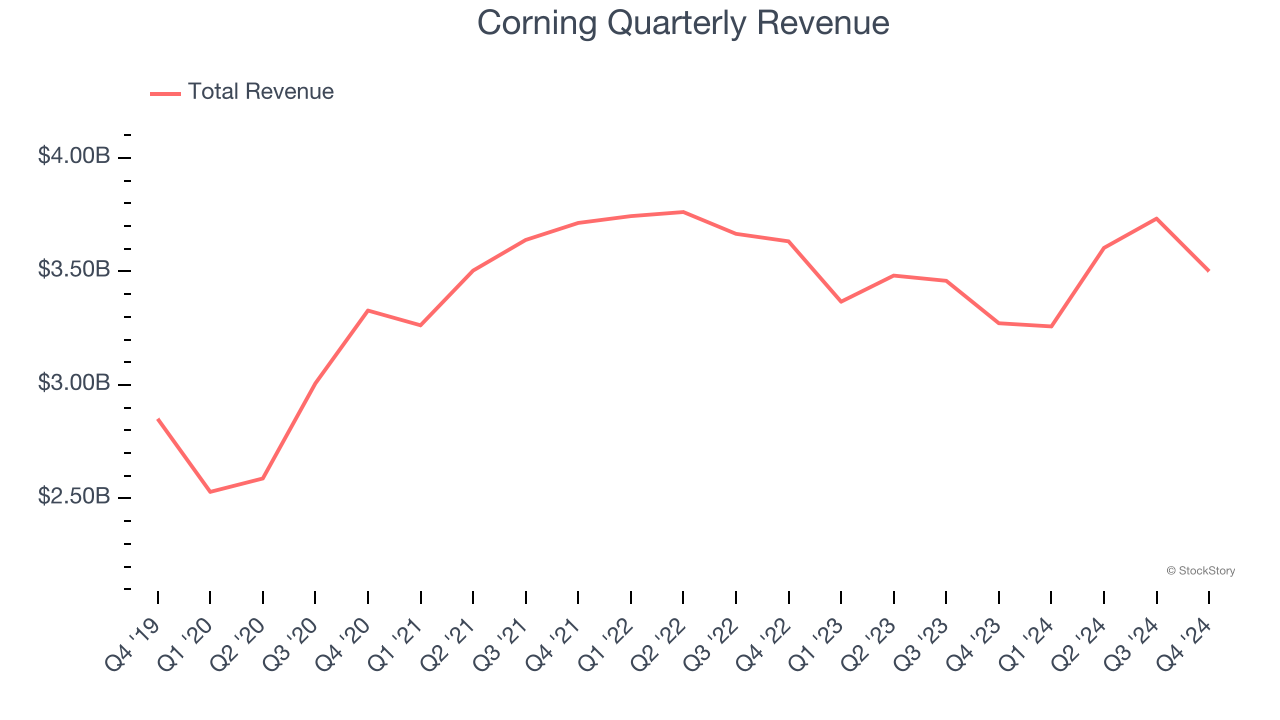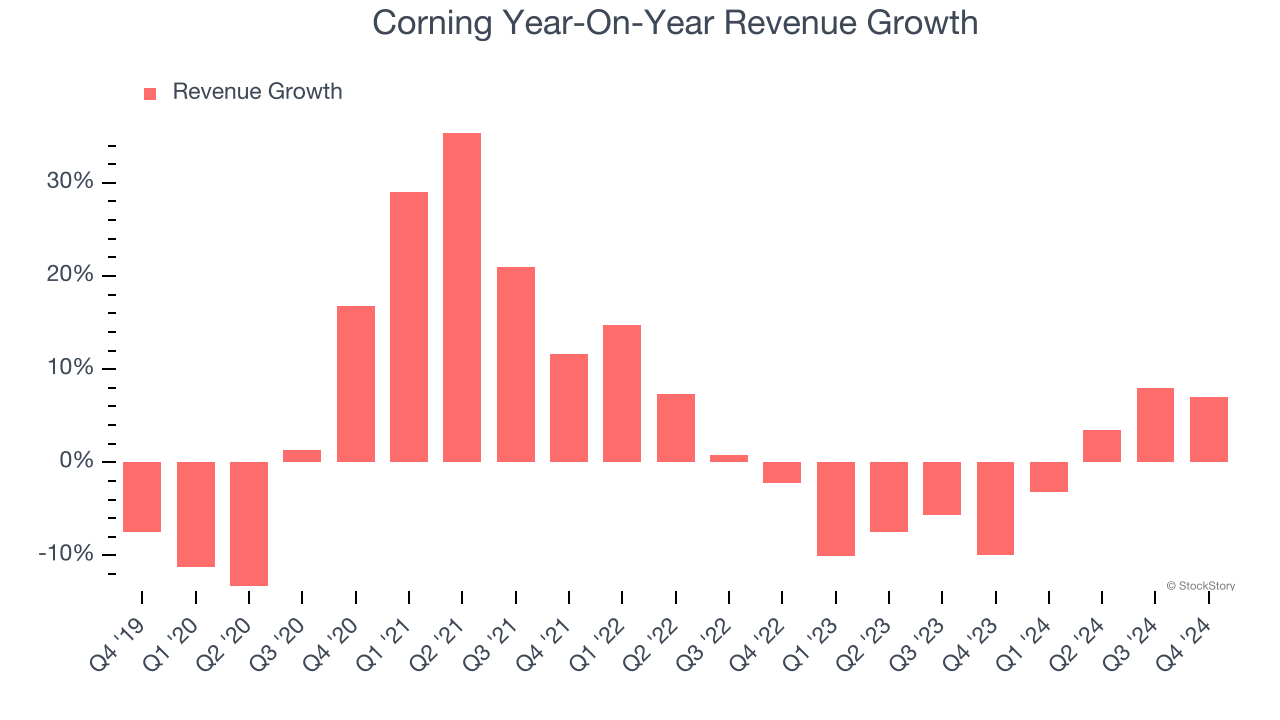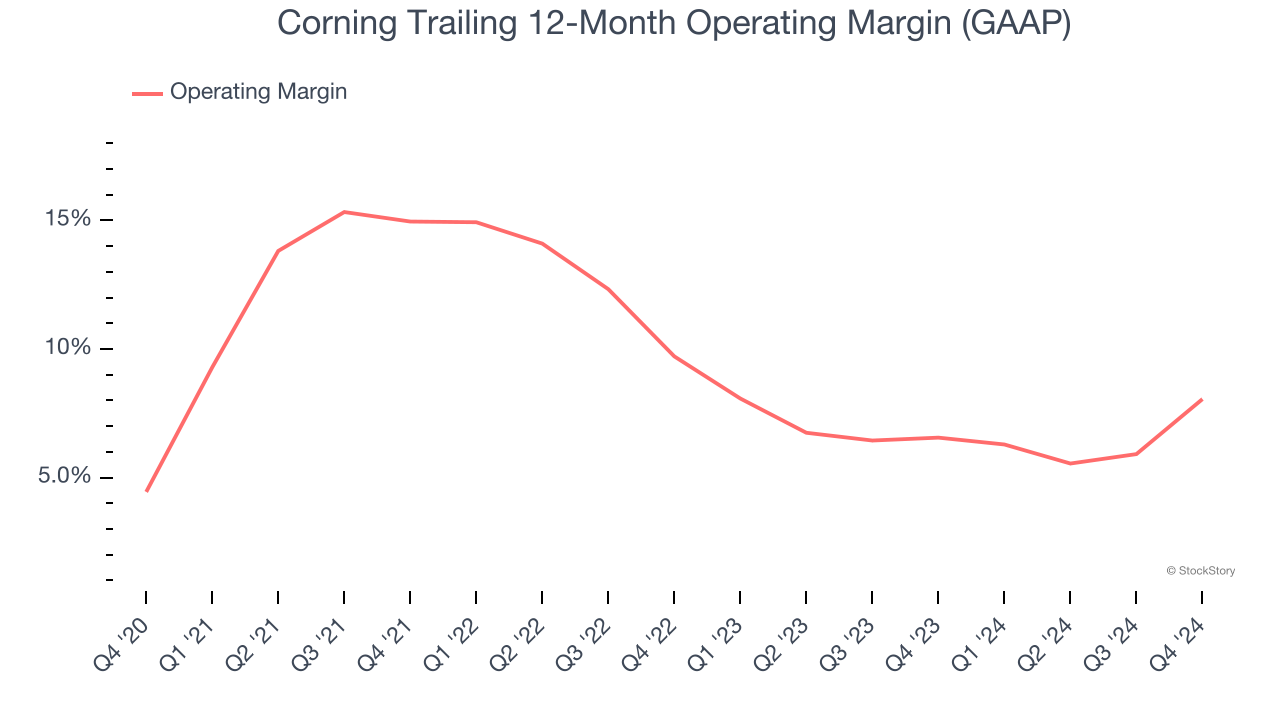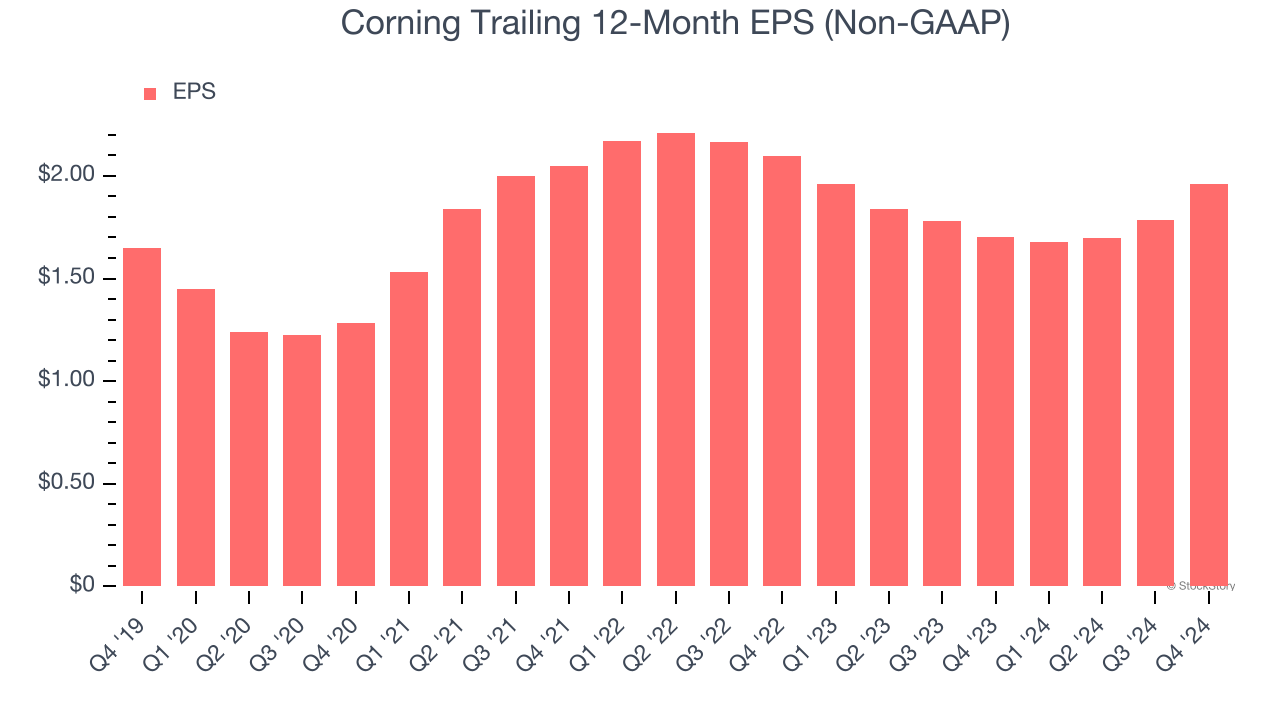
Glass and electronic component manufacturer Corning (NYSE:GLW) missed Wall Street’s revenue expectations in Q4 CY2024, but sales rose 7% year on year to $3.50 billion. On the other hand, next quarter’s outlook exceeded expectations with revenue guided to $3.6 billion at the midpoint, or 2.1% above analysts’ estimates. Its non-GAAP profit of $0.57 per share was 2.2% above analysts’ consensus estimates.
Is now the time to buy Corning? Find out by accessing our full research report, it’s free.
Corning (GLW) Q4 CY2024 Highlights:
- Revenue: $3.50 billion vs analyst estimates of $3.76 billion (7% year-on-year growth, 6.9% miss)
- Adjusted EPS: $0.57 vs analyst estimates of $0.56 (2.2% beat)
- Revenue Guidance for Q1 CY2025 is $3.6 billion at the midpoint, above analyst estimates of $3.52 billion
- Adjusted EPS guidance for Q1 CY2025 is $0.50 at the midpoint, above analyst estimates of $0.48
- Operating Margin: 11.2%, up from 2.4% in the same quarter last year
- Free Cash Flow Margin: 10.5%, down from 14.9% in the same quarter last year
- Market Capitalization: $43.86 billion
Company Overview
Supplying windows for some of the United States’s earliest spacecraft, Corning (NYSE:GLW) provides glass and other electronic components for the consumer electronics, telecommunications, automotive, and healthcare industries.
Electronic Components
Like many equipment and component manufacturers, electronic components companies are buoyed by secular trends such as connectivity and industrial automation. More specific pockets of strong demand include data centers and telecommunications, which can benefit companies whose optical and transceiver offerings fit those markets. But like the broader industrials sector, these companies are also at the whim of economic cycles. Consumer spending, for example, can greatly impact these companies’ volumes.
Sales Growth
A company’s long-term performance is an indicator of its overall quality. While any business can experience short-term success, top-performing ones enjoy sustained growth for years. Over the last five years, Corning grew its sales at a sluggish 3.9% compounded annual growth rate. This fell short of our benchmark for the industrials sector and is a rough starting point for our analysis.

Long-term growth is the most important, but within industrials, a half-decade historical view may miss new industry trends or demand cycles. Corning’s history shows it grew in the past but relinquished its gains over the last two years, as its revenue fell by 2.4% annually. Corning isn’t alone in its struggles as the Electronic Components industry experienced a cyclical downturn, with many similar businesses observing lower sales at this time. 
Corning also breaks out the revenue for its most important segments, Optical Communications and Display Technologies, which are 39.1% and 27.7% of revenue. Over the last two years, Corning’s Optical Communications revenue (optical fiber & cables) was flat while its Display Technologies revenue (glass for flat panel displays) averaged 9.7% year-on-year growth.
This quarter, Corning’s revenue grew by 7% year on year to $3.50 billion, missing Wall Street’s estimates. Company management is currently guiding for a 10.5% year-on-year increase in sales next quarter.
Looking further ahead, sell-side analysts expect revenue to grow 8.5% over the next 12 months, an improvement versus the last two years. This projection is above average for the sector and indicates its newer products and services will fuel better top-line performance.
Today’s young investors won’t have read the timeless lessons in Gorilla Game: Picking Winners In High Technology because it was written more than 20 years ago when Microsoft and Apple were first establishing their supremacy. But if we apply the same principles, then enterprise software stocks leveraging their own generative AI capabilities may well be the Gorillas of the future. So, in that spirit, we are excited to present our Special Free Report on a profitable, fast-growing enterprise software stock that is already riding the automation wave and looking to catch the generative AI next.
Operating Margin
Corning has done a decent job managing its cost base over the last five years. The company has produced an average operating margin of 8.9%, higher than the broader industrials sector.
Looking at the trend in its profitability, Corning’s operating margin rose by 3.6 percentage points over the last five years, showing its efficiency has improved.

This quarter, Corning generated an operating profit margin of 11.2%, up 8.8 percentage points year on year. The increase was solid, and since its gross margin actually decreased, we can assume it was recently more efficient because its operating expenses like marketing, R&D, and administrative overhead grew slower than its revenue.
Earnings Per Share
We track the long-term change in earnings per share (EPS) for the same reason as long-term revenue growth. Compared to revenue, however, EPS highlights whether a company’s growth is profitable.
Corning’s weak 3.5% annual EPS growth over the last five years aligns with its revenue performance. On the bright side, this tells us its incremental sales were profitable.

Like with revenue, we analyze EPS over a more recent period because it can provide insight into an emerging theme or development for the business.
For Corning, its two-year annual EPS declines of 3.2% show it’s continued to underperform. These results were bad no matter how you slice the data.
In Q4, Corning reported EPS at $0.57, up from $0.39 in the same quarter last year. This print beat analysts’ estimates by 2.2%. Over the next 12 months, Wall Street expects Corning’s full-year EPS of $1.96 to grow 18.7%.
Key Takeaways from Corning’s Q4 Results
Even though its revenue missed significantly, Corning exceeded analysts' EPS expectations this quarter. We were also glad its revenue and EPS guidance for next quarter came in higher than Wall Street’s estimates. Overall, this was a decent quarter. The stock traded up 8.6% to $55.71 immediately after reporting.
So should you invest in Corning right now? If you’re making that decision, you should consider the bigger picture of valuation, business qualities, as well as the latest earnings. We cover that in our actionable full research report which you can read here, it’s free.














